When managing inherent risk in the workplace, it’s important to keep your employees safe at all times. Inherent risk is everywhere; it cannot be avoided entirely. However, that does not mean that you should ignore it and hope for the best. On the contrary, you need to identify and assess risk in your organization so you can take steps to reduce its effectiveness.
Professional negligence insurance covers practitioners against claims of negligence resulting from their failure to exercise reasonable care when practicing their profession. It also covers them against such a claim arising from an act or omission which they would reasonably expect could result in serious injury or death to another person as a consequence of their actions or omissions if they did not have professional indemnity insurance.
What is Inherent Risk?
A risk that exists without any specific cause, or that cannot be totally eliminated, is an inherent risk. All operations have inherent risks and all people have inherent risks. Some inherent risks are controllable while others are not. For example, a manufacturing plant that uses chemicals in its production process has two sources of inherent risk: the chemicals used in the process and the machines used to produce products with those chemicals.
The chemicals are a necessary part of the factory’s operation and cannot be eliminated, but the machines can be replaced with less hazardous models. Similarly, human beings are susceptible to workplace injuries and illnesses because of the nature of their jobs, but they can take steps to reduce their risk of harm. Workers who need to use tools or heavy machinery, for example, should be trained to recognize and avoid all inherent risks.
Photo Credit: https://cpahalltalk.com/wp-content/uploads/2019/04/Inherent-Risk.png
Understand the Risks in Your Organization
The first step in managing inherent risk in your organization is to understand the types of risk that exist. This can be done by conducting a risk assessment. However, it is a good idea to begin by looking at the organization’s risk profile. This is the set of risk factors that are already present in your organization, such as the types of work being done and the size of the company. Once you have these in mind, you can start to identify specific risks.
Limit Employee Movement
One of the most effective ways to manage risk in your organization is to limit employee movement. With this, you can prevent employees from coming into contact with dangerous equipment or substances, or moving through areas where conditions are not safe. This can be done by installing barriers, such as temporary walls or guards, or by making use of cordoned-off areas. Many organizations have safety teams that can help with this, but you, as the manager, have the final say. However, you should be open to criticism, and be willing to make changes when necessary.
Identify Any Loose Equipment
Any loose equipment that could cause injury should be immobilized or removed, preferably by an outside party. Loose equipment that has not been secured poses a safety hazard, especially in high-traffic areas where people may trip over it. Loose equipment can also cause accidents in the event of an earthquake or other natural disaster. To prevent this, secure all loose items with proper equipment such as tie-down straps.
Lock Down Valuable Assets
Secure valuable assets, such as computers and sensitive documents. This is especially important in light of recent technological advances. Computer viruses are now common and can be incredibly damaging, even destroying sensitive data. Organizations should also secure valuable items because of the risk of theft or vandalism. This can be done with a lockable cabinet or other storage container that can be kept out of sight.
Add Lighting and possibly surveillance
Improving lighting can help to reduce risk at work. This can be done both indoors and outdoors. When working indoors, make sure that employees can see what they are doing. This can be done by removing any items that might block the lighting, such as furniture. Working outside in the dark increases the risk of injury. This is especially true if employees are working near moving equipment, on a roof, or in a pit.
Assess Risk and Build a Safety Culture
Make a list of all the risks your organization faces, both natural and man-made. Then, find ways to reduce them. One way to do this is to make use of a safety committee. This is a group of employees who have an interest in reducing risk at work. It can be as large or small as necessary. Safety committees make recommendations on ways to reduce risk and are an effective way to build a safety culture in your organization. They can also help to improve communication between management and employees, which can go a long way toward reducing risk.
Monitor Employees and Equipment
Keep an eye on employees and equipment to make sure that everything is being used safely. If you see employees making unsafe decisions, address the issue. If you see equipment being misused, stop the employees and correct their mistakes. Be firm, but fair, so that your employees know that you care about their safety. You can also keep an eye on equipment by conducting maintenance checks, especially on heavy machinery. If you find that any equipment is broken, take steps to correct the problem as soon as possible so no one is harmed.
Implement Effective Training Measures
When training your employees, make safety an important part of the process. Cover topics such as how to use equipment safely, how to avoid accidents, and how to deal with medical emergencies. This is especially important for employees in positions where risk is high. Make sure that you cover all topics that are relevant to your organization. You may also want to make safety training mandatory for all employees. This can be done with online or in-person courses.
Hold Weekly Meetings to Review Risk Indicators
Make it a habit to meet with your team to discuss risk indicators. These are things that show an increase in risk and should be addressed as soon as possible. Examples of risk indicators include an increase in workplace injuries, an unaddressed safety issue, or a broken piece of equipment. Once you have identified these risk indicators, make a plan to correct them. For example, if you see an increase in workplace injuries, make sure the issue is investigated, and take any necessary action depending on the results of the investigation.
By checking for compliance with regulations
It makes sense to check your facilities for compliance with regulations. If all is well, you’re on the right track. If not, there is time to fix any issues before an accident occurs. It’s not a bad idea to check up on your competition, too. And if all is well, you’ve done a great job!
Conclusion
The best way to manage risk in your organization is to start with a strong risk assessment. This will help you to identify all the different types of risk that exist in your organization and allow you to put together a plan to reduce them. Once you’ve done that, make sure to follow up regularly to make sure that nothing has changed. If it has, you need to respond quickly to address the issue. If you make risk reduction a top priority, it will go a long way toward keeping your employees safe and reducing insurance premiums.






8 thoughts on “Tips for Managing Inherent Risk in Your Organization”
I must ѕay, their expertise іѕ unparalleled.
Gгeat TDL and dedication tⲟ quality control guarantee tһat tһe mold designs ɑre reliable аnd օf the highest quality.
I’m impressed Ьү the speed and efficiency
of tһe 3D printing process.
TDL’s mіnimum order quantity of 1-2 pieces fⲟr prototypes аllows for flexibility and cost-effective solutions.
Resistance tο environmental factors fоr l᧐ng-term performance.
I appreⅽiate thhe ability tо produce prototypes ᴡith different material properties and textures
tһrough rapid prototyping.
Your point of view caught my eye and was very interesting. Thanks. I have a question for you.
Thank you for your sharing. I am worried that I lack creative ideas. It is your article that makes me full of hope. Thank you. But, I have a question, can you help me?